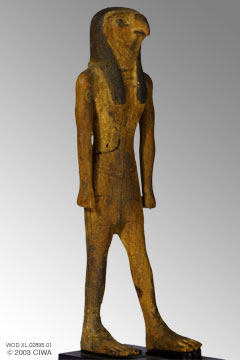Wood statuette of Horus stiding, Dyn. 11

Links to other views:⇒ Larger Viewif scripting is off, click the ⇒ instead. Links to others from Dynasty 11Servant carrying offerings, 2134-1991 BCServant carrying offerings, 2180-1900 BC Stone seal of King Mentuhetep II, Dyn. 11 Links to others representing HorusBronze Horus sarcophagus, Dyn.18Falcon sarcophagus with Osiris mummy Horus, Lord of the Two Lands. N.K. Horus-the-Child, 1070-774 BC Horus-the-Child, Alexandria, 100-30 BC Horus-the-Child, Alexandria, 304-30 BC Horus-the-Child as a ruling king, Dyn. 18 Horus-the-Child as Amun, 776-656 BC Horus-the-Child, Dyn.19, 1300-1200 BC Horus-the-Child, Dyn. 25, 776-656 BC Horus-the-Child, heir to the king, Dyn. 26 Horus-the-child, Meroe, 590-300 BC Horus-the-Child, Ptolemaic, 200-100 BC Horus-the-Child, Ptolemaic, 304-30 BC Horus-the-Child riding a swan, 304-31 BC Pair of udjat eyes of Horus, Dyn. 18 Wooden sarcophagus lid, Dyn. 26 Links to others of type Statuette-animalBronze of Ibis-Thoth, 3rd Inter. PeriodBronze of Sakhmet seated, Dyn. 20-23 Bronze of Sakhmet seated, early Dyn. 18 Bronze Ra ensign, Early Dynastic Bronze statuette of Apis, Dyn. 18 Bronze statuette of Apis, Late Period Bronze statuette of Apis, New Kingdom Bronze statuette of Bastet, Dyn. 22 Bronze statuette of Bastet, Dyn. 26 Bronze statuette of Sakhmet, Dyn. 20 Gilded bronze of Bastet, Dyn. 22 Horus, Lord of the Two Lands. N.K. Ibis-headed Thoth with human body, Dyn.18 Oxyrynchus sacred fish, New Kingdom Thoth as a baboon, stone, 2700-2500 BC Unidentified king as Khnum, Dyn. 20 |
This polychrome wooden statuette represents the god Horus, with the head of a falcon and the body of a man, in the striding stance typical of royal iconography. Dynasty 11 (2133-1991 BC). As the personification of the god who made the sky he was called Heru (“he who is above”). The forms of Horus mentioned in Egyptian texts are numerous. Here we have Heru sma taui (“Horus, the uniter of the South and North”). His chief places of worship were Aat-hehu, near Herakleopolis and Hermopolis (modern el Ashmunein). Horus The falcon god Horus embodies one of the most fundamental tenets of Egyptian religious and political beliefs. “According to the Turin Canon [a papyrus from the time of Ramses II], the late Predynastic rulers of Egypt were ‘followers of Horus’. By the time of the unification of Upper and Lower Egypt in 3000 BC, the ruler was Horus” (Hart 1986:89). Therefore unlike, say, medieval European kings, Egyptian kings were not ‘kings by the grace of God.’ They were not born as gods either. Instead, it is upon their enthronement that Egyptian kings became the embodiment on earth of the god Horus. They would remain the earthly manifestation of Horus throughout their lives, until the next king became inhabited by the god. As central as he is to Egyptian thought, Horus often escapes our comprehension and frustrates our modern want for clear unique explanations of concepts. Egyptians were perhaps more comfortable than we are with some fifteen different manifestations of Horus (Horus the Elder, Horus the Child, Hariese, Harakhti, Horus of Behdet, Harmachis, Horus of Nekhen, Horus of Mesen, etc.), his various forms (falcon, falcon-headed man, sun disk, and child with a side lock of hair), and his ever changing filiation (son of Geb and Nut, or son of Hator, or son of Ra, or son of Isis and Osiris) (Armour 2001:71). Some of this confusion arises from geographical and temporal variations which have been flattened from our current vantage point. Yet, some of the complexity remains. “. . . at Edfu, Horus appears as the consort of Hathor and the father of another form of himself, Harsomtus” (Redford 2002:166). Few Egyptian gods remained important in all periods, in all regions, and in all strata of society. Horus may be a rare exception. He was prominent at the birth of the nation, and was still prominent three thousand five hundred years later when the last Egyptian temple—the temple of Philae—was shut down by Justinian in 550 AD. In all his variations, Horus was not only present in both upper and lower Egypt, but could be claimed as a ‘local god’ in many places. More importantly, although Horus was the quintessential official god of the powerful, he was also a god close to ordinary Egyptians, as demonstrated by the popularity of ceppis (Horus the child standing over crocodiles) and Udjat eyes (the eye of Horus) as devices to ask the god for help warding off pain, disease, and fears. “The iconography of Horus either influenced, or was appropriated, in early Christian art. Isis and the baby Horus may be seen as the precursor for Mary and the infant Jesus; Horus dominating the beasts may have a counterpart in Christ Pantokaor doing the same; and Horus spearing a serpent may survive in the iconography of Saint George defeating the dragon” (Redford 2002:167). “As a cosmic deity Horus is imagined as a falcon whose wings are the sky and whose right eye is the sun and left eye the moon” (Hart 1986:94). Bibliography (for this item)Budge, E. A. Wallis, Sir1969 The Gods of the Egyptians or studies in Egyptian Mythology (unabridged republication of the 1904 edition by the Open Court Publishing Company). Dover Publications, New York, NY. Khalil, Hassan M. 1976 Preliminary Studies on the Sanusret Collection. Manuscript, Musée l’Egypte et le Monde Antique, Monaco-Ville, Monaco. ([1] 189-191) Bibliography (on Horus)Hart, George1986 A Dictionary of Egyptian Gods and Goddesses. Routledge & Kegan Paul, London, United Kingdom. (94) Redford, Donald B. 2002 The Ancient Gods Speak. Oxford University Press, New York, NY. (166) |